Gavriil Skorodumov
Gavriil Ivanovich Skorodumov (Russian: Гавриил Иванович Скородумов; 12 March 1755[2] – 12 July 1792)[3] was a Russian engraver,, known for his work for Robert Sayer in London.[4][5][3]
Gavriil Skorodumov | |
|---|---|
Гавриил Иванович Скородумов | |
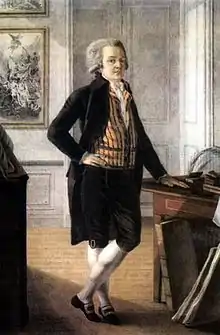 Self portrait. Watercolor (about 1785) | |
| Born | March 12, 1755 |
| Died | July 12, 1792 (aged 37) |
| Education | Member Academy of Arts (1785)[1] |
| Alma mater | Imperial Academy of Arts (1773)[1] |
| Known for | Engraving |
| Awards | |
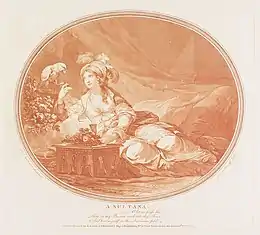
Biography
He was born into a family of hereditary craftsmen. In 1764, he was admitted to the Imperial Academy of Arts, where he studied painting and engraving with Grigoriy Srebrenitsky, Johann Stenglin and Anton Losenko. In 1772, he graduated with a large gold medal for his engraving, "Lot with His Daughters", after a painting by Louis-Jean-François Lagrenée. The medal came with a grant for travelling abroad.
The following year, he and Mikhail Belsky, another grant recipient, went to London together. He studied in the workshop of the famous engraver, Francesco Bartolozzi, where he learned engraving techniques that were not in use in Russia (stippling and the "crayon manner"). Before he had finished his studies, he was already taking orders from local publishers, reproducing works by Joshua Reynolds and Benjamin West. He established his fame with 24 engravings based on works by Angelica Kaufman, an especially fashionable artist.
Although he was supposed to leave England in 1776, he continued to put off his return to Russia for as long as possible. He finally yielded in 1782, when he heard that Empress Catherine admired his work and would "give him a thousand two hundred rubles and a thousand for the trip, if only he promised not to be lazy".[6] Upon his arrival in St. Petersburg, she named him Court Engraver and caretaker of engravings at the Hermitage Museum, with a salary of 1,200 Rubles, an apartment worth 600 Rubles, and his own personal printer. .
Things did not go as well as planned, however. Within a few months of his arrival, the Empress was apparently tired of his constant complaints and hinted that he was free to leave if he wished. In 1783, she noted that nobody had seen any of his works. In the Spring of 1784, she suspended his salary until he had something to show for it.[6] Nobody knows for certain why his productivity declined, although drinking has been suggested as a likely cause. In 1789 the writer, Ivan Krylov, published a satirical piece in his magazine, "Почта духов", (roughly, letters from the spirit, or soul), in which one of the characters, an artist named Trudolyubov (Hardworking), laments that he misses England, was better paid there, and is so depressed that he became a drunkard.[7]
During the last few years of his life, he managed to produce some engravings and portrait miniatures. In 1791, he began work on an album, with twelve scenes of St. Petersburg, that was never completed. On the day of his death, he was the guest of a merchant named Strunnikov. After dinner, he laid down on some damp grass to take a nap. By evening, he had become deranged, and was dead before morning, aged only thirty-seven.[8]
Works
 Reflections on Clarissa Harlow[9] (1775)
Reflections on Clarissa Harlow[9] (1775)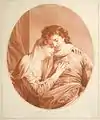 Farewell Romeo and Juliet[10] (1775)
Farewell Romeo and Juliet[10] (1775) Cleopatra[9] (1776)
Cleopatra[9] (1776)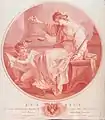 Justice[9] (1777)
Justice[9] (1777)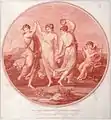 Dance of the graces[9] (1778)
Dance of the graces[9] (1778) Sacrifice to Ceres[9] (1778)
Sacrifice to Ceres[9] (1778)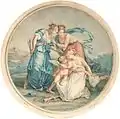 Cupid trying to get back his arrows[9] (1777)
Cupid trying to get back his arrows[9] (1777)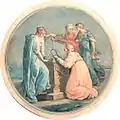 Love sacrifice[9] (1778)
Love sacrifice[9] (1778) Abelard and Eloise, overtaken by Fulber[9] (1778)
Abelard and Eloise, overtaken by Fulber[9] (1778) Farewell of Abelard and Eloise[9] (1780)
Farewell of Abelard and Eloise[9] (1780)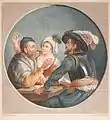 Gamblers[11] (1778)
Gamblers[11] (1778)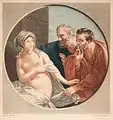 Susanna and the elders[12] (1779)
Susanna and the elders[12] (1779) Diana and Acteon[13] (1781)
Diana and Acteon[13] (1781)
References
- Directory of the Imperial Academy of Arts 1915, p. 439.
- A Sultana. Victoria & Albert Museum. Retrieved 11 February 2016.
- "Kauffman and the print market in eighteenth-century England" by David Alexander in Wendy Wassyng Roworth (Ed.) (1992) Angelica Kauffman: A continental artist in Georgian England. London: Reaktion Books. p. 157. ISBN 0948462418
- Alexander, p. 142.
- Gabriel Scorodomoff. Fine Arts Museums of San Francisco. Retrieved 11 February 2016.
- Письма Екатерины II к Гримму… (Letters from Catherine to Grimm), Русского Исторического Общества, 1878
- "Почта духов", СПб, 1789, pp.123, 124.
- D. A. Rovinsky, Подробный словарь русских граверов (Detailed Dictionary of Russian Engravers) СПб, 1895
- from the original of Angelica Kauffman
- from the original of Benjamin West
- from the original of Dirck van Baburen
- from the original of Guido Reni
- from the original of Carlo Maratta
Literature
- С. Н. Кондаков (1915). Юбилейный справочник Императорской Академии художеств. 1764-1914 (in Russian). 2. p. 439.
External links
![]() Media related to Gavriil Skorodumov at Wikimedia Commons
Media related to Gavriil Skorodumov at Wikimedia Commons
